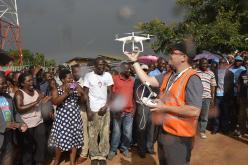Working in Malawi has always been exciting. As a student in conflict and development, I came to the country to conduct research on street vendors and organizational structures in the markets. Three years later, I find myself working with unmanned aerial vehicles (UAVs), or drones, as part of UNICEF’s emergency flood response.
Malawi has limited road access to rural areas, and after a flash flood earth roads can turn to rivers, completely cutting off affected communities. Using drones, we fly over the affected area and see clearly what the impact has been on the ground, using this information to inform the disaster response.
The Disaster Coordinator, Blessings, called the crisis team together to discuss the assessment mission, the benefits of drones and how they can assist in coordinating the response. Aerial photography and video can identify damage to buildings, bridges, crops and wells, giving us information about when families can return home and what help they will need.
Our team — the drone pilot Owen, Blessings, Watson and myself — grew by three additional members: Spear, Madalitso and Sangani. The assessment site was a maize field around 1.5 km from the village, which was as close as we could safely get to the affected area. After some final instructions from the locals on flying directions, Owen got everything ready and the drone took off. Bystanders eagerly watched it disappear into the sky, then crowded around Owen’s controller to watch. After 25 minutes flying and filming, the drone returned with a hard drive full of useful footage.
Assessments done using drones in an emergency response shouldn’t involve only technical staff. They should be led by the community themselves.
With the latest equipment, a pilot can fly the drone while another person moves the camera. With the help of secondary screens, local residents can instruct the camera controller and get the best footage. Collected data can be uploaded to the Internet to make use of crowd-sourcing to process detailed maps to give to the community leaders, allowing them to make more informed decisions to support their community.
In Malawi, we will see the best results if we combine the latest technology with local know how. Working hand in hand with communities, we can deliver the best possible disaster response and help families and children put their lives back together more quickly.
This story first appeared in full-length on Medium by UNICEF Malawi. This version of the article was edited by UN Online Volunteer Erika Morris.

